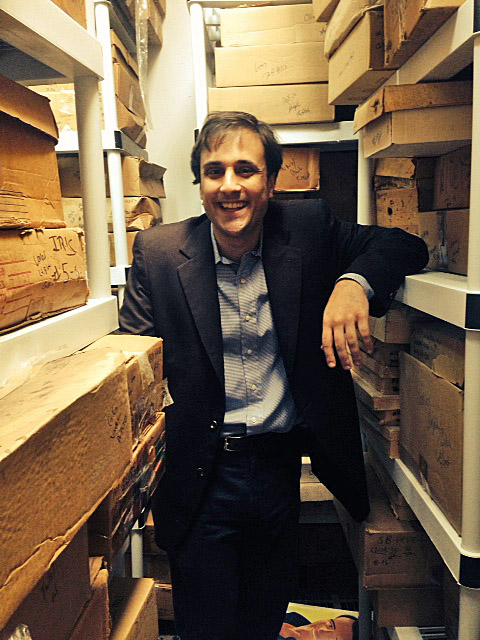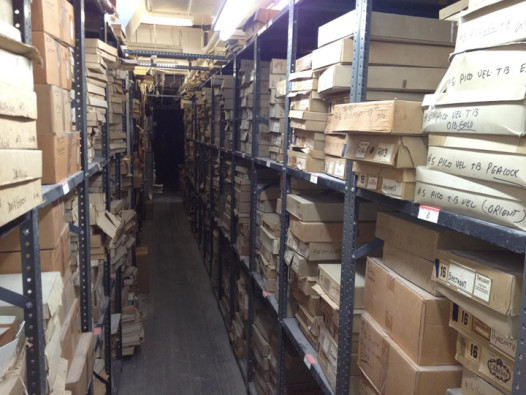
Cole Halpern in the ribbon warehouse behind Promenade Fine Fabrics on St. Charles Avenue. (Photo: Renee Peck)
Almost the entire left wall inside the Promenade Fine Fabrics store on St. Charles Avenue is filled with spools of ribbon. Floor to ceiling. Satin, grosgrain, velvet, brocade, in a rainbow of hues. Pansy purple, seagull, Irish green. Peacock and bamboo and moss leaf.
And most of it is old — vintage ribbon from famous fabric houses in Germany or France or Italy, dating from the 1920s to the 1970s.
Third-generation cloth merchant Cole Halpern knows every yard. In the warehouse behind the store, where he spent more than a year of 18-hour days labeling some 9 tons of the stuff, he can pull whatever you fancy at a moment’s notice – a heavy velvet plaid, perhaps, or a thin gold weave dotted with blue embroidered forget-me-nots. There’s 10-inch opera fringe in metallic gold from Germany, and boxes of lush black velvet in ever-bigger widths.
The story of how Halpern traveled from law school in New Orleans to a dusty warehouse in Queens to find these venerable but delectable lengths of fine ribbon is an interesting one.
“I had never even considered learning the fabric business,” says Halpern, whose father, Herbert Halpern, has been running Promenade for 48 years. “Then during my second year of law school I figured out I didn’t want to be a lawyer. I came to the store to work for awhile, and by the second week, I was hooked.”
The hook might have been set, but what landed Halpern was his first buying trip to New York City, five years ago, and a visit to the Queens warehouse of venerable ribbon wholesaler Hyman Hendler. The proprietor, Michael Weisman, son-in-law of the founder, was a good friend of his father.
“They were a ribbon company that had started out in millinery in 1900,” Halpern explains. “Towards the end they were the best-known ribbon house in New York, supplying Oscar de la Renta, Carolina Herrara, Bill Blass, virtually every designer in New York. I took one look and just fell in love with his ribbon.”
So, when Halpern learned in 2012 that Hyman Hendler was closing its doors, he saw an opportunity.
“I called him and convinced him to let me come up. He was being evicted from the store on a Friday, and I got up there on that Wednesday. On Thursday morning I went to the 38th Street store and cleaned it out, picking the best of the best.”
Halpern eventually came home with 18,000 pounds of vintage ribbon.
“I packed it into 24 huge boxes, and when we ran out of boxes we started filling suitcases. We would take them back to my friend’s place in the Bowery, where I was staying, and then go back for more. It really was an adventure.”
Halpern, relatively untutored in ribbon lore at the time, chose randomly but selectively.
“I was looking for what I thought was the most interesting, the most special. The prize ribbon was the brocade, for its interest, complexity and beauty. I also focused on satin, because it’s our bread and butter, and his is the finest in the world. Vintage satin is heavier – you can’t compare it to even contemporary French satin. A lot of these are one of a kind.”
He cornered the market on some rare ribbons, too.
“At one point a lady who worked there handed me a trash bag she had filled with gold bouillon ribbon. She said, ‘I want you to have this, and no one else.’”

The Hyman Hendler warehouse in Queens (Photo: Cole Halpern)
Halpern spent the next year traveling back and forth to New York, where he combed the Hyman Hendler warehouses for more choice yardage.
“I had a friend who would help me stuff boxes into the car and we’d take them to UPS to ship home. I’d be riding the subway carrying grosgrain fabric and bolts of ribbon.”
The timing was propitious: After some lean years for fabric stores when the market ran mostly to bulk goods made in Asia, the niche fine fabric and trim market is on the upswing. Credit a young population that has rediscovered crafting and sewing, and a burgeoning fashion and film industry in the city.
“New Orleans actually has a cutting room now. And this year we had the biggest Carnival season ever,” Halpern says. “It is really cool to see our fabric and ribbon in American Horror Story. Or to spot Kathy Bates wearing our silk charmeuse at the Emmys.”
Promenade is now starting to sell vintage ribbon nationally, even internationally. “We’re one of the few places where you can get some of the rare vintage ribbons,” Halpern says.
His ribbon can run from $20 or $30 to upwards of $100 a yard, although something like the vintage gold opera fringe would probably cost half again as much to make now.
He’s learned a lot since graduating law school and starting full-time in the family business. In the early days, he’d come in hours before opening to study the fabric dictionary. “But the most important thing is that I had a hell of a teacher,” he says with a grin, pointing to his dad. “He taught me every little detail; how to burn the fabric, how to feel the fabric.”
Not that Herbert Halpern was an instant fan of his son’s interest in stockpiling vintage ribbon.
“He said, what are you going to do with all this? Where the hell are we going to put it?” Halpern recalls with a laugh. “I said, we’ll find the room.”
These days, Halpern’s passion for his product is evident in voice, gesture, touch. He pulls out a spool of peau de soie ribbon. “Oscar de la Renta used this,” he says. “It’s literally the finest ribbon ever made in the history of the world, including the Egyptians. The heft, the weight, the color set it apart.”
He turns to another shelf and pulls out bolts of Tersuisse ribbon from Switzerland, one of the first rayon blends, made from the ‘60s to the ‘80s. The tour continues, into a room filled with satins, and on to an adjacent wall stacked with brocades. Rooms crowded with taffetas and plaids and velvets, every flat brown box hand labeled with width and fabric and color in black Sharpie.
A German cotton velvet from the ‘50s had sat for years on a shelf untouched, Halpern says. “We were the only people in the U.S. who got it from the Queens warehouse.”
The grosgrain fabric was a find as well. “The story is that the company in France that made grosgrain ribbon decided to get into the fabric business, so they widened their machines and made fabric out of the grosgrain ribbon material. We got 98 percent of what’s left out of the warehouse, and as far as I know are the only ones who have it.”
Another unique discovery was the first version of polyester, tergal, which came out in the ‘70s.
Ultimately, such vintage ribbons and fine fabrics are as much artisanal products as farm-made cheese or microbrewed beer, says Halpern.
“You can’t replace this,” he comments, sweeping his arm toward the wall of vintage ribbons. “Once it’s gone, it’s gone.”
He’s an old-line merchant, finding a niche in a world that is rediscovering the beauty of old-line merchandising.
“This store is a dinosaur, but it represents the very kind of thing people are coming to New Orleans for, to appreciate the past,” Halpern says. “History here is based on tradition, and New Orleanians cherish this kind of thing.”
 NOLAbeings
Multimedia artist Claire Bangser created NOLAbeings as a portrait-based story project that marries...
NOLAbeings
Multimedia artist Claire Bangser created NOLAbeings as a portrait-based story project that marries...
 Data corner: Adobe Suite (create a PDF, social media graphic, presentation, edit a photo and video
Data corner is where you go to work with analytics and top tech skills. It takes on everything from PERL and SQL to Canva and Sprout Social.
Data corner: Adobe Suite (create a PDF, social media graphic, presentation, edit a photo and video
Data corner is where you go to work with analytics and top tech skills. It takes on everything from PERL and SQL to Canva and Sprout Social.
